More Sugar, More Problems
Added sugar plays a significant role in the school’s snack options
May 13, 2019
Whenever you step into NASH, you are immediately confronted by a vending machine. There’s one by the athletic entrance. There are a few by the main entrance doors and scattered around the cafeteria. There’s even one by the band room in the music wing. Each is loaded with sugary sodas, teas, and juices.
We all know that too much sugar is not healthy for us, but at school, there aren’t very many options that don’t contain added sugar upon entering the building.
First, there is a big difference between naturally occurring sugars (like those found in unprocessed fruits and milk) and added sugars (any type of sweetener or sugar added during processing). Added sugars are not just found in desserts like cakes or pies; beverages can be one of the largest sources of added sugars, as well as savory foods like bread and pasta sauce. The nutrition labels on products can be deliberately vague when it comes to sugar; the sweet substance is measured in the unorthodox gram instead of a unit of volume. 4.2 grams of sugar is approximately 1 teaspoon of the stuff. Furthermore, there are 61 different names that can substitute “sugar” on a nutrition label, including anything ending in “-ose,” barley malt, high fructose corn syrup, and rice syrup.
The American Heart Association recommends a maximum amount of added sugar per day as 9 teaspoons (about 36 grams) for men and 6 teaspoons (about 24 grams) for women. In reality, the average American consumes about 82 grams of added sugar per day. That adds up to about 52 pounds of added sugar per year. One 20 ounce bottle of Coca-Cola contains 65 grams of sugar, all of which is added. A 12 ounce can has 39 grams. But soda is not the only beverage to contain added sugar. Sweet teas, some juice drinks, pasta sauces, ketchup, and energy drinks are also big offenders.
It’s not just beverages, either. One chocolate candy bar contains about 20 grams. Half a cup of vanilla ice cream has 14 grams. A tablespoon of store bought salad dressing? 4 grams. Even a slice of white bread adds 2 extra grams of sugar to your diet. This begs the question: in all of the drinks, pasta meals, and sauces offered by the school cafeteria, how much added sugar are we being fed? Many people don’t eat fruits or vegetables at lunchtime, much less try to avoid soda and sugar.
Consuming excess sugar doesn’t just lead to the typical health risks commonly associated with a bad diet, like obesity, heart disease, and flash-and-crash energy spikes. Sugar negatively impacts the ability to learn and remember; it causes a spike in dopamine similar to a drug; it temporarily decreases cortisol (the hormone that causes stress) for a short time but promotes more stress later; it accelerates skin aging; and it accelerates oxidation in cells, potentially causing damage to proteins, tissues, and organs.
Reducing added sugar intake can decrease risk of cardiovascular disease, diabetes, liver disease, kidney failure, and more. People have to take steps to reduce their sugar intake, whether that means packing their own lunches or avoiding sugary drinks from vending machines.












